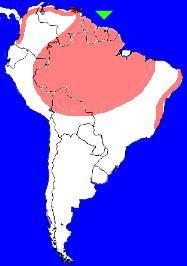 Red-legged Honeycreeper (Cyanerpes cyaneus)
Red-legged Honeycreeper (Cyanerpes cyaneus)
 Red-legged Honeycreeper (Cyanerpes cyaneus)
Red-legged Honeycreeper (Cyanerpes cyaneus) |
 |
| Red-legged Honeycreeper: They often come in groups to flowering trees with other nectar eating birds like purple honeycreepers and blue dacnis, without rest on the search for food. The first two pictures were made by Dennis Binda in August 2008 on the Brownsberg near a fruiting Clusia grandiflora, a strangler liana. The third picture was made by Carla Out, a male Red-legged Honeycreeper also eating at a fruit of Clusia grandiflora at the Brownsberg but in September 2006. The female was photographed by Foek Chin Joe at Matta in August 2006. Follow two pictures by Francita Rijhiner made in September 2011 in Anaula and first a photo made by J.H. Ribot in the bird-cage of mr. Luchmun, Paramaribo 2001. One of a male with its very red legs was made by Carla Out in the Brownsberg nature park in September 2006. Then follow two of a young male, not yet in full color. The first of these made in the bird-cage of mr. Luchmun, Paramaribo 2001, the black and white picture at Hannoversavanne in Suriname 1980, both by Ribot. Then a picture of a female, made by Pascal Dubois in French Guyane (2002) and a male from the same country seen by Michel Giraud-Audine near wayabo in March 2014. Dominiek Plouvier filmed a female out of a group of 10 exx that showed up in Commewijne at the end of June. |
 |
| Video (click the link or the 'play'-button to see) | ||
|---|---|---|
| Video recording of a Red-legged Honeycreeper © ; |
|
|
||||||||||||||||||||||||||||||||||||||||||||
| Observations through the year | Observations of breeding through the year |
|---|---|
| The 408 reported observations of this bird in Suriname, mainly for the last 50 years up to 2018, have been grouped by month. More birds on one day are counted as one observation. Of course, if the graph should depict the total number of birds seen, the differences between the months could be much more pronounced. | The 1 reported breeding observations of this bird in Suriname. Most observations are about nest with eggs, some about fledglings, or feeding at a nest or the building of a nest. Of the about 5000 nests and eggs found for all species together, about 1/3 comes from the egg collection of Penard between 1896 and 1905. For some reason most collecting then was done in the first half of each year, so the shown distribution does not necessarily reflect the actual breeding preferences. The main dry season in Suriname is reckoned to be from half August to the end of November, the main wet season from half April to half August, but the the timing of begin and end does vary from year to year. Around March a second dry season often occurs. |